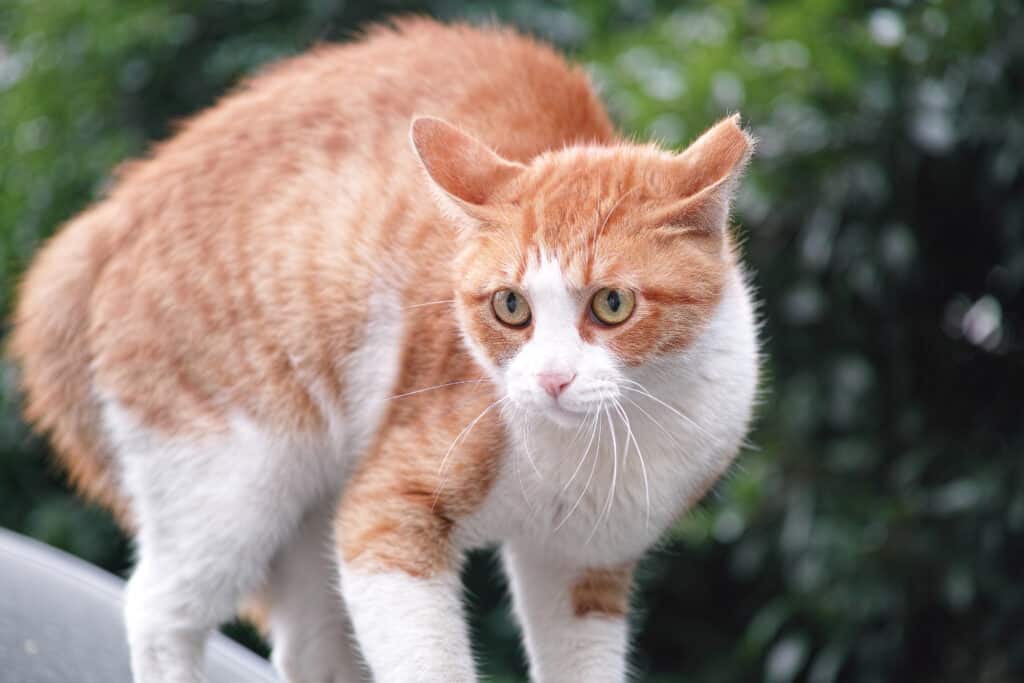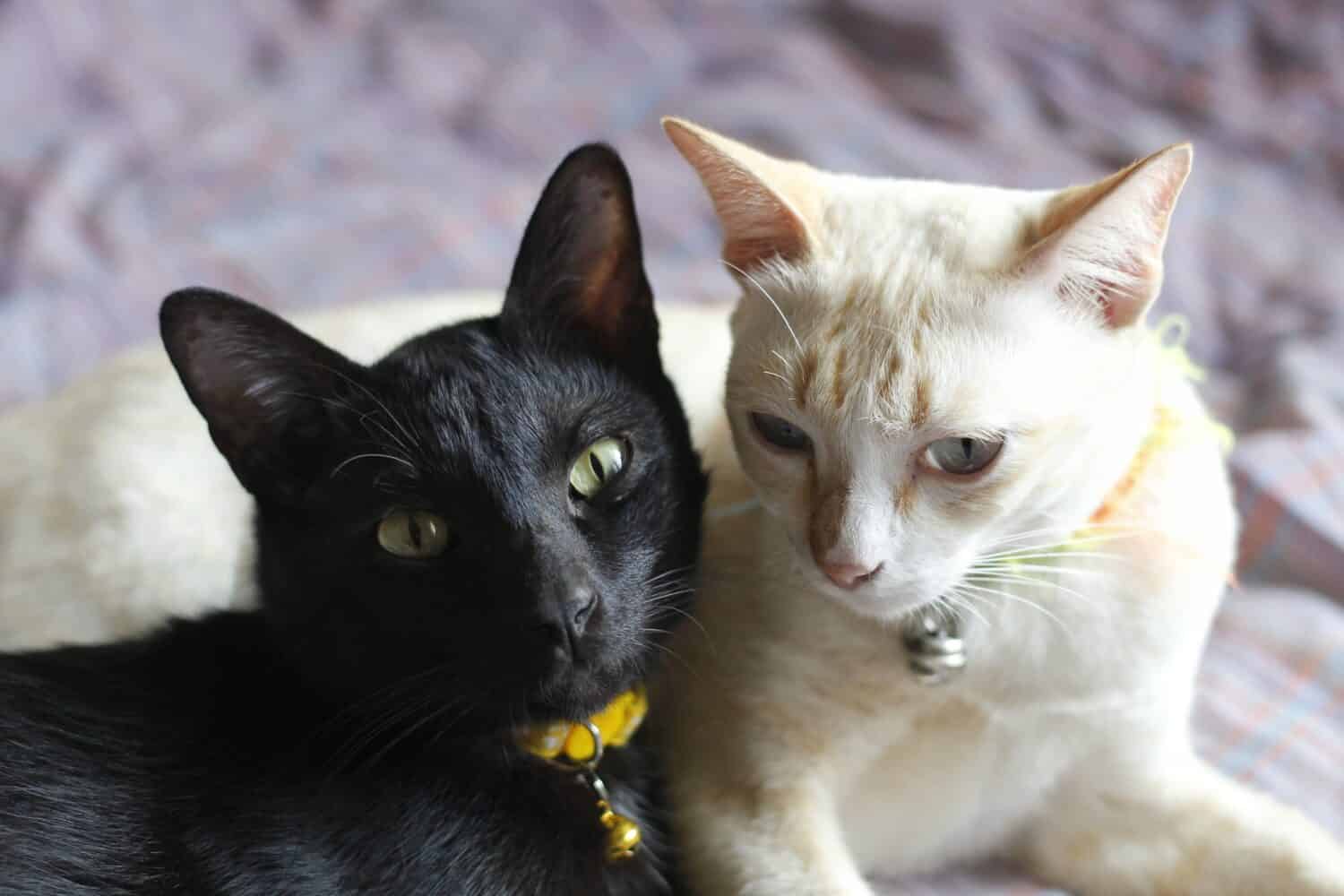You’ve just adopted a new kitty. Most stores like PetSmart and Petco offer a booklet with tons of free items and discount toys. From choosing the right food to selecting a good scratching post, it can be challenging learning to navigate life with a new furry friend. One of your first challenges will be whether or not to give your cat a collar.
There are many advantages and a few disadvantages to getting a bell collar for your cat. But your biggest concern is likely safety — are bell collars safe for your cat? Can they damage the ears of sensitive kitties? Could your cat become caught up by its collar and possibly choke? In short — yes, bell collars are safe for cats. They will not cause hearing damage and they have mechanisms to prevent your kitty from getting tangled up. Keep reading to find out why and how bell collars are safe for cats.

Your new friend may enjoy wearing a bell collar.
©Yarkovoy/Shutterstock.com
Hearing Damage?
No, your cat’s bell collar will not cause hearing damage to them. This is because the decibel at which bell collars sound is so low — 50 to 60 dB — that they won’t bother your cat. In fact, studies have shown that anything under 80 dB won’t cause damage or bother a cat’s ears. You can rest easy knowing that the little bell won’t cause tinnitus or other hearing issues for your cat long term. In fact, some studies have found that cats’ brains will actually filter out the sound of the bell after hearing it for long enough. They should eventually just forget that it’s there.
Anxious Cats
While the noise isn’t loud enough to cause damage, the ring of the bell may cause a bit of anxiety for cats who are prone to the condition. Cats who have bad anxiety are not the best candidates for wearing bell collars. The collar can lead to more anxiety and nervousness, so it’s best to choose an alternative — like a regular collar without a bell.

Cats with anxiety are not the best candidates for wearing bell collars because they may heighten their anxiety.
©iStock.com/toxawww
Collar Safety
When choosing a collar for your cat, you need to be sure that it’s a break-away collar. Because they are common practice for cat collars, you should only see break-away collars when you purchase one from the store. This is why it’s important for cats to wear cat collars instead of dog collars. Break-away collars keep your cat safe in the event that they get hung up on their collar. Once enough force is applied to the collar, it will simply break off and the cat will be free from whatever they are hung on. This keeps cats from choking or getting stuck in the narrow and tight spaces they love to find.
Reasons to Use a Bell Collar
Now that you know a bell collar is safe for your feline friend, you may be wondering what positives there are to using one. Cat collars are great for many different reasons depending on whether you have an indoor or outdoor cat.
Outdoor Cats
If you have an outdoor, or indoor/outdoor cat, you may have received a “present” from them. These “presents” usually come in the form of a dead bird, squirrel, or other animal that they’ve captured to make you proud. If you get a lot of these creatures on your doorstep, you’re probably wondering how to keep your cat from bringing gifts all the time.
A bell collar is a great solution for cats who are constantly hunting and bringing down prey. The bell will alert the prey to their location, and at least give them a fair chance of escaping in time. While you may still find the occasional dead animal on your doorstep, adding a bell to your cat’s collar will prevent them from taking down prey most of the time.
Something to keep in mind with an outdoor cat that is wearing a bell collar is your cat’s safety. While the bell will alert prey to your cat’s location, it can also alert predators to where your cat is. This can put your cat in danger, so it’s best to think carefully about the pros and cons of putting a bell collar on your outdoor cat. If possible, the best and safest place for your cat to be is inside. Some cats do love the outdoors, so it can be tricky turning an outdoor cat into an indoor cat. If you have a nature-loving feline, you can bring them indoors and still give them the time they enjoy outside. Many cats take well to walking on a leash, riding in a pet stroller for walks, or simply having a “catio” or outdoor space to sit and soak up the sun.

Outdoor cats can wear bell collars, but they may make them less safe from predators.
©atiger/Shutterstock.com
Finding Fluffy
For outdoor and indoor cats, a bell is also a great way for you to know where your kitty is. While it won’t always work for outdoor cats, whose range and territory are much larger, it will definitely help locate your indoor cat. This is great for kitties who like to get into trouble, like rustling through the trash or going into a certain room. You’ll constantly hear the soft “ding” of the bell on their collar, so you’ll know if they get into an area they shouldn’t be in.
However, cats are very smart animals. In time they may learn to walk around without causing the bell to ding. Many cats eventually learn this trick eventually, so you may notice that you hear the bell less and less. That doesn’t mean that your cat isn’t moving around, though!
Reducing Cat Fights
If you have multiple cats, giving each cat a bell collar can help reduce the number of fights they have. Wearing a collar will alert your kitty when another cat is nearby. If your cats have already established an order of dominance, the non-dominant cat will likely run away when they hear the ding of the dominant cat’s collar. This is a healthy and easy way to avoid cat fights amongst your resident cats.

Bell collars are great for multi-cat households.
©Wasuta23/Shutterstock.com
Alternatives to Bell Collars
If you like the benefits of having a bell collar on your cat but aren’t sure if you like the idea fully, there are some alternatives. One of these alternatives is buying a cat collar with a detachable bell. This way, when you want your cat to have a bell, you can put it on their collar, and then remove it when you don’t. The only disadvantage to this method is that your cat will have to get used to the sound again every time you put the bell on. This may lead to your cat moving and spinning to try and locate the bell to pull it off the collar. This usually only lasts a short time. If you remove and replace the collar over and over, though, they may never fully get used to the sound.
If it’s prey that you’re worried about, there’s another alternative that’s a bit more interesting — cat bibs. Cat bibs are bright pieces of fabric that go around your cat’s neck and help prevent them from catching prey. Scientific studies have shown that these rainbow-colored bibs are equally as effective in keeping prey safe from cats as bell collars. They make it so the cats are very easy to spot and give birds and other prey an equal chance. A few companies sell them, including the more popular birdsbesafe brand, and pet owners like them a lot. It’s also really fun to see your cat wearing a silly, rainbow-colored bib.
The photo featured at the top of this post is © Sheila Fitzgerald/Shutterstock.com
Thank you for reading! Have some feedback for us? Contact the AZ Animals editorial team.






